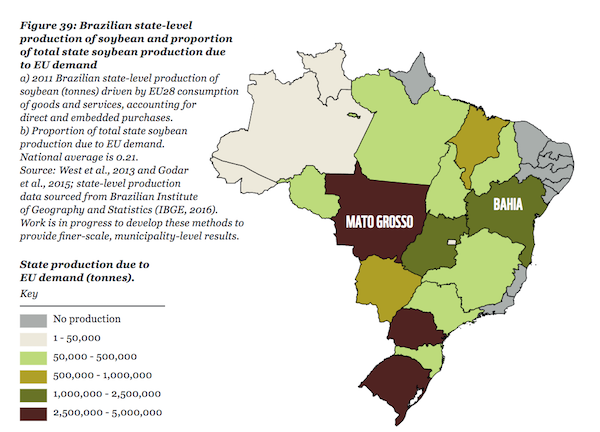SEI’s Chris West and Simon Croft talk about the section they contributed to the new Living Planet Report 2016.

On 27 October WWF published its biennial Living Planet Report for 2016. The Living Planet Report is a review of the health of the living environment (including the “Living Planet Index”) along with analysis of the environmental pressures imposed by human activity. A section in the 2016 report is written by SEI’s Chris West and Simon Croft, and presents ongoing work by SEI to link consumption activities to specific production sites along often complex global supply chains. Chris West and Simon Croft explain (with contributions from Jonathan Green).
Q: What is your contribution to Living Planet Report 2016 about?
A: We contributed a two-page section on linking production to consumption, focused on the case of soy exported from Brazil. The Living Planet Reports use the global Ecological Footprint as a measure of consumption-based resource pressures. This metric provides a simple, easy to communicate picture of overall natural resource use. But as it doesn’t express where the resources were used, it can’t be used to quantify deforestation, biodiversity loss and so on; and in turn how consumption affects the Living Planet Index.
Our section describes how recent advances in methods and data availability are opening up new opportunities to quantify environmental impacts and to link consumption to production, so we can generate more nuanced, policy-relevant insights into how consumers – in fact actors all along the supply chain – affect ecological risks linked to production.
The bulk of it is a case study of Brazilian soy to illustrate the new insights available. It uses SEI’s IOTA multi-regional input-output model and data from the SEI-PCS tool, supported by the work of SEI’s Initiative on Producer to Consumer Sustainability (P2CS). We looked at consumption by the European Union and provided “soybean footprints” at state level. It shows that the EU depends on soy production in regions of Brazil of high biodiversity concern, in particular the Cerrado region. Although we chose to look only at the level of states, SEI-PCS data actually goes down to the level of individual municipalities.

Q: What work is going on within SEI to advance and apply this kind of analysis?
A: Much of SEI’s work in this area takes place under the umbrella of the P2CS initiative, which combines advanced modelling techniques with other multidisciplinary approaches, particularly direct work with supply chain actors, to bring a step change in our understanding of production-to-consumption systems.
One of the most exciting applications is the Trase platform, developed with the Global Canopy Programme, which is being launched next month at COP22. This platform will allow users to explore, for free, supply chains for some of the key land-based commodities and production regions associated with deforestation. Trase uses dynamic maps to show links from importer countries back to localities of production, taking in the various traders and other actors along the way and highlighting their exposure to deforestation (and other) risks.
In the PRINCE project we are part of a team using input-output modelling to develop indicators of the environmental pressures linked to Swedish consumption in countries and regions around the world.
SEI is collaborating with WWF, the Luc Hoffmann Institute and others, on the new Contacted project, which is hoping to develop a new approach for biodiversity conservation by combining fine-scale data on biodiversity impacts with supply chain mapping, policy analysis and stakeholder engagement.
SEI is also involved in a number of projects, notably the new IKnowFood Programme, which bring multiple disciplines together to explore food systems resilience and sustainability. In these projects our progress in linking production and consumption is being brought to bear on issues such as sustainable nutrition, socio-economic inequalities, and farm-level technology applications. The work raises questions such as how actors along supply chains could and should respond to both production- and consumption-driven policy changes; what political, governance and behavioural constraints there are to changes in production-to-consumption systems; and what unintended consequences policies intended to create more sustainable food systems could have.
Finally, we are working on improving modelling methods and data utilization to underpin the development of an extended set of environmental and social indicators. This is focused on improving the accuracy and fidelity of impact data, as well as enhancing sharing and communication of informative, contextualized results. These could be used to quantify consumption-driven impacts on, for example, biodiversity and natural capital, while providing meaningful and actionable information for producers, intermediaries, consumers, policy actors and governance.
Design and development by Soapbox.


